2021 for Mantua will be theyear of Venus. From March 21 to December 12, 2021, the project Divine Venus. Harmony on Earth, produced and organized by the Fondazione Palazzo Te and the Museo Civico di Palazzo Te, and promoted by the Municipality of Mantua under the patronage of MiBACT and with the contribution of Fondazione Banca Agricola Mantovana, offers three exhibitions and a program of events (culminating in a conference attended by important names in art history) will explore the myth of Venus as a representation of the sense of rebirth from antiquity to modern times.
The program benefits from a scientific committee composed of Stefano Baia Curioni, Francesca Cappelletti, Claudia Cieri Via and Stefano L’Occaso, and was conceived by Fondazione Palazzo Te to complete a reflection on the femininestarted in 2018 with the exhibition Tiziano/Gerhard Richter. Heaven on Earth, and continued in 2019 with Giulio Romano: Art and Desire. The project is developed in three exhibition moments, from a survey of the iconographic heritage of Palazzo Te to a reflection on the current power of the myth of the goddess, with a program that creates encounters with some of the great masterpieces of Western art from important European museums, from paintings by Cranach, Guido Reni, Titian and Dosso Dossi to sculptures, tapestries and books.
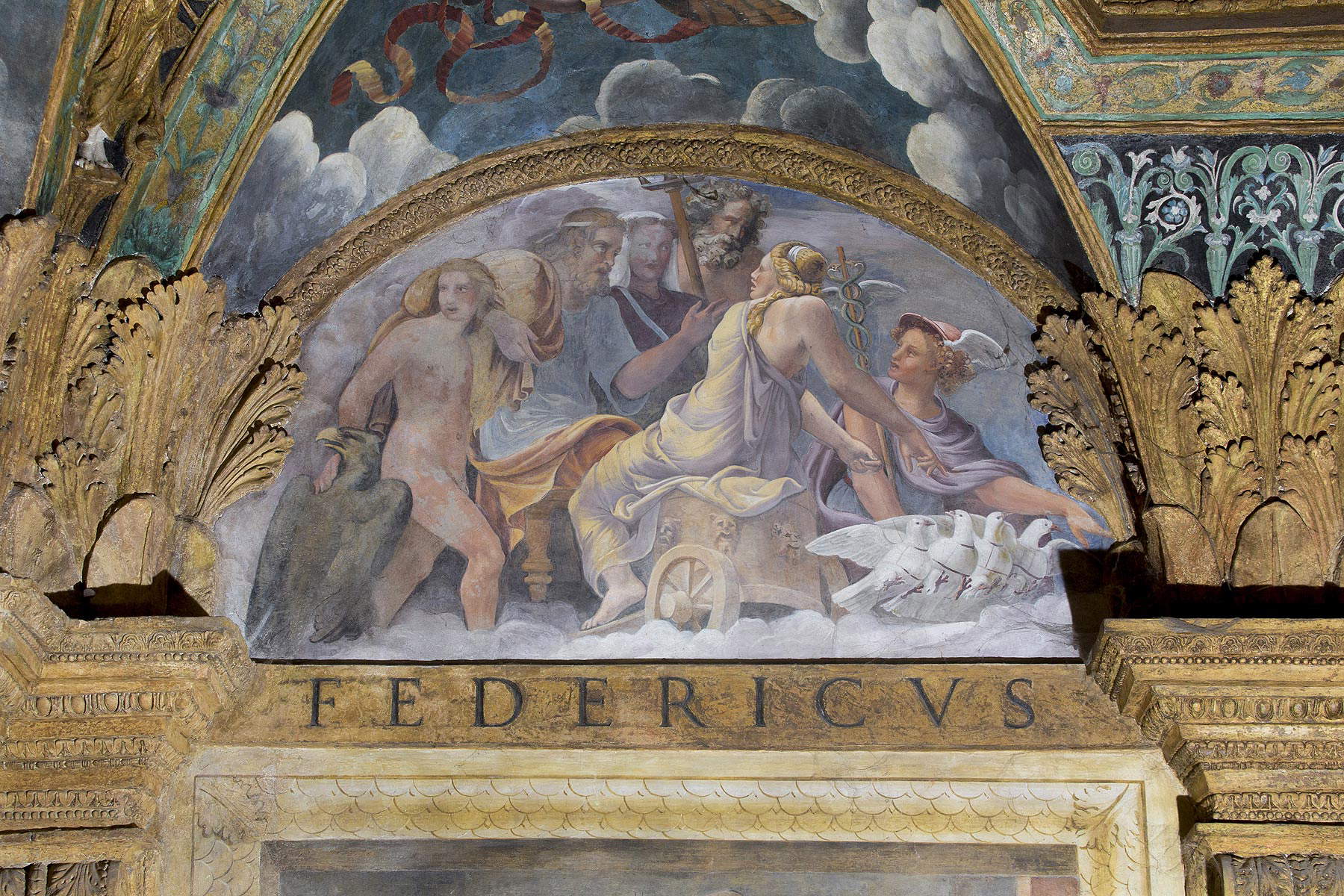 |
| Giulio Romano and pupils, Venus obtains from Jupiter the availability of Mercury (1527; fresco; Mantua, Palazzo Te, Camera di Amore e Psiche). Photo: Gian Maria Pontiroli © Fondazione Palazzo Te |
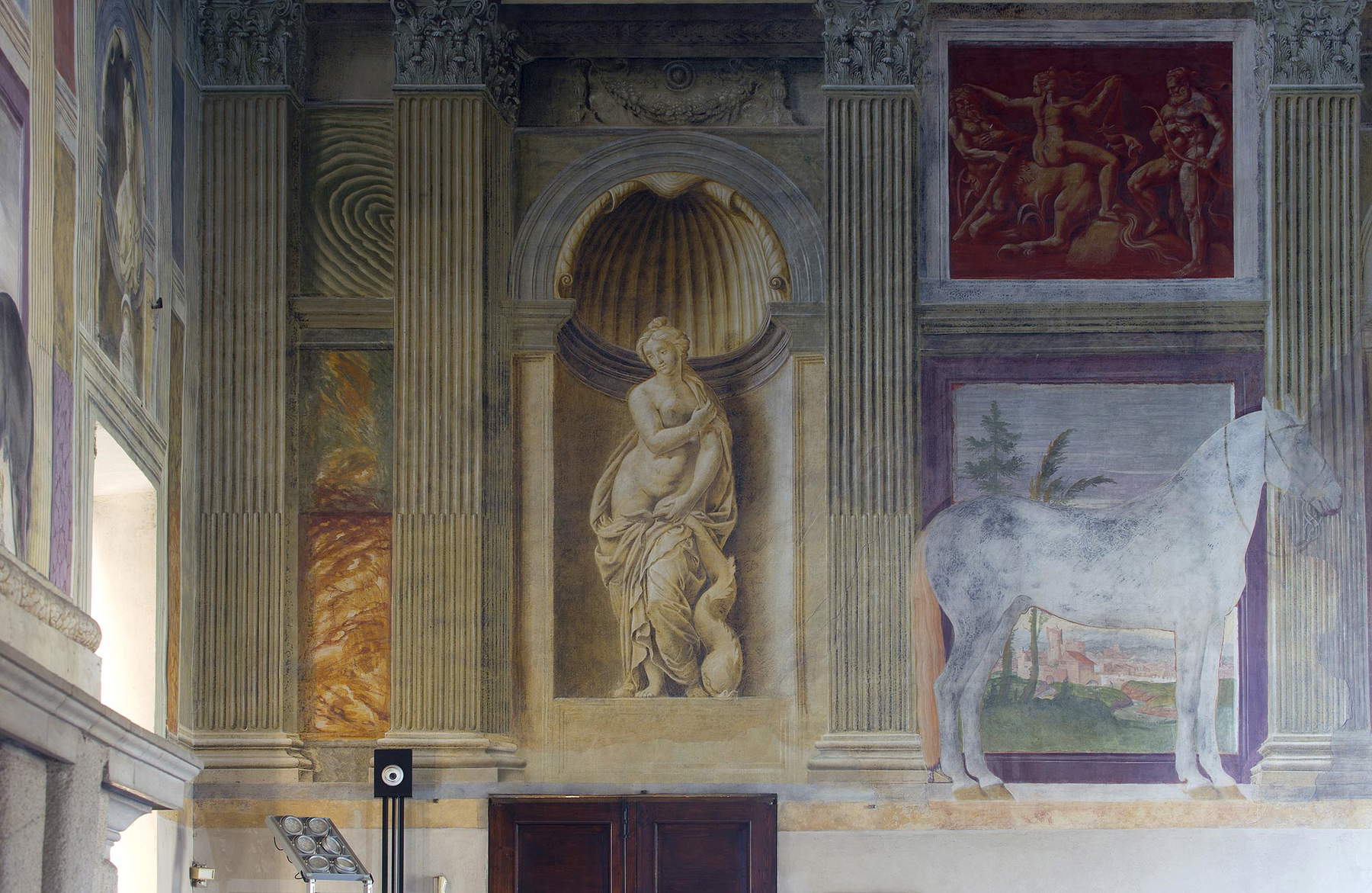 |
| Giulio Romano and pupils, Venus Marina (1525-1526; fresco; Mantua, Palazzo Te, Sala dei Cavalli). Photo: Gian Maria Pontiroli © Fondazione Palazzo Te |
The first stage opens with The Myth of Venus at Palazzo Te, which from March 21 to December 12, 2021 allows the public to discover the more than 25 representations of Venus, including stuccoes and frescoes, in the Palazzo. A journey through ancient myths and fables, also collected in a printed and multimedia guide, which is enriched with the exhibition of the sculpture Veiled Venus from the collection of the Municipality of Mantua, which belonged to Giulio Romano and is preserved in the Galleria dei Mesi at Palazzo Ducale, and of the tapestry Venus in the Garden with Putti, made by Flemish weavers based on a design by Giulio Romano himself, recently returned to Mantua thanks to a complex purchase operation conducted by the Gonzaga royal palace, the MiBACT Directorate General for Museums and with the support of Fondazione Palazzo Te. The Myth of Venus at Palazzo Te is also the occasion that will lead Palazzo Te to organize an international conference on the theme of Venus in the spring, as anticipated. The conference aims to reason around Venus, focusing on its different aspects: from the classical origins of the myth to its survivals in culture, mythographic and poetic literature and images up to the early seventeenth century. Participants include Giuseppe Capriotti(Le Favole fra mito e allegorie: immagini e testi), Georges Didi-Huberman(Ninfa fluida), Claudia Cieri Via(Venere e i suoi disestimenti), Philippe Morel(Le altre facce di Venere), Emilio Russo(Venere nella letteratura del Seicento), Francesca Cappelletti(I Camerini delle Belle) and Stefano L’Occaso(Venere nell’arazzo di Giulio Romano).
The itinerary is intended to be a “compelling adventure,” as the Fondazione Palazzo Te states. Venus is a goddess of Greek Olympus with many facets: consecrated goddess of beauty by the judgment of Paris, Venus expresses the deepest values of nature (from the fecundity proper to the parent Venus, to the Venus Anadiomene who is born from the sea, to the sublimation in the celestial Venus). The presence of Venus as the protagonist of the decorations of Palazzo Te, already referred to as the “shrine of Venus,” expresses the founding character of this deity, through her aspects, even contradictory ones, which are expressed in the different representations of her figure, from the demure Venus, to the Veiled Venus, to the Winning Venus to the mythological fables that see her involved in a marriage with the elderly Vulcan, in an erotic passion with Mars, in an amorous involvement until death with Adonis. Venus, then, is an expression of abstract concepts: beauty, love Eros, Nature, Spring, fecundity, often taking shape, even through disguises, in the characters of ancient fables, such as Ariadne, Olympias, Psyche, Antiope, and all the numerous woodland nymphs and Nereids handed down by the imagination of the ancient world. The itinerary aims to lead visitors through the rooms of Palazzo Te in search of Venus, and it is presented as articulate and varied. The presence of Venus in frescoes and stuccoes is most often to be grasped in her features, which, expressing ancient philosophical thought, take shape in sculptures and reliefs, transmitted through specimens that have survived through time or replicated in medals and coins in collections of antiquity and reproposed as such in the decorations of the Mantuan palace.
The vitalistic imprint of the decorations of Palazzo Te is thus expressed through the artistic experimentation of Giulio Romano and his pupils, informing the paintings from the varied artistic techniques. The richness of the decorations, almost bordering on a horror vacui, generates an involvement of the visitor who is invited to enter the large decorative installations, to search and observe with attention and enjoyment the detailed figurations and ornamentations that fill every space of the walls and ceilings of the rooms, enlivening every stucco relief and every old-fashioned decoration with flowers, birds and sophisticated ornamental motifs derived from the so-called “grotesques” discovered in Rome in the Domus aurea, the ancient house of Nero, which contributed to a fantastic renewal of the 16th-century decorative language. The reproposal of a repertory use of antiquarian collecting and newly discovered ancient models, observed in Rome by Giulio Romano, finds an elaboration in the formal language of the artist and his pupils in Mantua, fixing those ancient models in the light of their revitalization and expressive scope, now playful now dramatic, which is manifested in the frescoes of Palazzo Te, particularly in the Camera di Psiche enella sala dei Giganti.
Two works arriving for the occasion will be part of the itinerary: theveiled Aphrodite from the City of Mantua, on deposit at the Ducal Palace, and the aforementioned tapestry with Venus playing with putti, from the Ducal Palace. The VeiledAphrodite statue, from the 2nd century B.C., was part of the Gonzaga collections dispersed with the sale of 1626-1627 and the sack of Mantua in 1630. Giulio Romano used this sculpture as a model for one of the ceiling stuccoes in the Hall of the Sun and Moon at Palazzo Te, and also for the figure of Diana in the Hall of Constantine in the Vatican (1520-1524). In addition, the master had envisioned a statue of Venus in the niche at the top of the door of his house in Mantua, a project that is changed with the placement of a sculpture of Mercury. The replacement of the statue indicates that a sculpture of Venus must have been in the possession of the artist who had to transport it from Rome to Mantua in 1524. Documents preserved in the Mantua State Archives recount the travels of the master’s collection of antiquities from Rome to Venice and then to Mantua. Giulio Romano had also enriched his collection of ancient marbles by purchasing collections, such as that of the antiquarian Giovanni Ciampolini, after his death in 1518. Of this collection of the Roman antiquarian, which included inscriptions, gems and statues placed in his home in Campo dei Fiori, this sculpture may also have been part of it, if identified as a Nymph “cinta d’un bel diaffan velo biancho.” After its arrival in Mantua and planned first placement on the facade of Giulio Romano’s dwelling, we have no further news of the statue. The work was saved from sale and the sacking of the city in an unidentified place, and the first mention traced in documents is dated 1879-1880.
The tapestry with Venus playing with putti was woven between 1539 and 1540 by Nicolas Karcher, a Flemish tapestry maker who moved to Mantua from Ferrara to set up his own manufactory in the city. The work is part of a series, of which eight cloths survive, called Giochi di Putti or Puttini, which was executed from a design and cartoon by Giulio Romano for Duke Federico II Gonzaga. The specific intended use of these tapestries has not been identified, but it is speculated that they were displayed in the bedroom of Margherita Paleologa, duchess of Mantua, in the little palace dedicated to her in front of the Castle of San Giorgio. After Gonzaga’s death in 1540, the series was completed by the tapestry maker by 1545 for Federico’s brother, Cardinal Ercole, bishop and regent of the city. Giulio Romano’s preparatory drawing for this tapestry is preserved in the collection of the Dukes of Devonshire at Chatsworth (Inv. OMD 107) and features a larger scene since it featured the figure of the dolphin, an animal sacred to Venus, from whose mouth water flowed. From the model Giulio Romano drew the cartoon of which only the portion representing Three Putti Playing with a Hare is preserved (Paris, Musée du Louvre, Département des Arts Graphiques, Inv. 3566). The cartoon reproduces in counterpart and scale a recognizable scene in the center of the tapestry that features a “Venus Genitrix” in a garden with putti playing, while behind her a satyr spies on her nudity. The model can be traced to the illustration of Francesco Colonna’s Hypnerotomachia Poliphili (Aldo Manuzio, Venice, 1499) or Correggio’s famous painting of Venus, Cupid and a satyr once in the Maffei collection in Mantua (Paris, Musée du Louvre, Inv. 42, c. 1525). Depicted in this serene natural setting are fruit trees on which vines climb, joining a pavilion on which wild roses grow. Elements of Dionysian symbolism merge with Christian symbols, which is why the figure of Venus has also been interpreted as the personification of Charity. The image of festive putti playing under the protection of a charitable Venus, beneath the heraldic enterprises of the work’s patron (the salamander or lizard and Mount Olympus), may refer to the return of the Golden Age, to the fruitful renewal brought to Mantua by the rule of Duke Federico II Gonzaga. The cloth displayed here belonged to a private Viennese collection, passed on the antiques market in London (1972-1973), and was purchased by art historian Federico Zeri, who had kept it until his death in 1998. The work then passed to the Raffaele Verolino Gallery in Modena and was recently purchased with a grant from the Fondazione Palazzo Te by the Ministry of Cultural Heritage and Tourism for the Ducal Palace in Mantua.
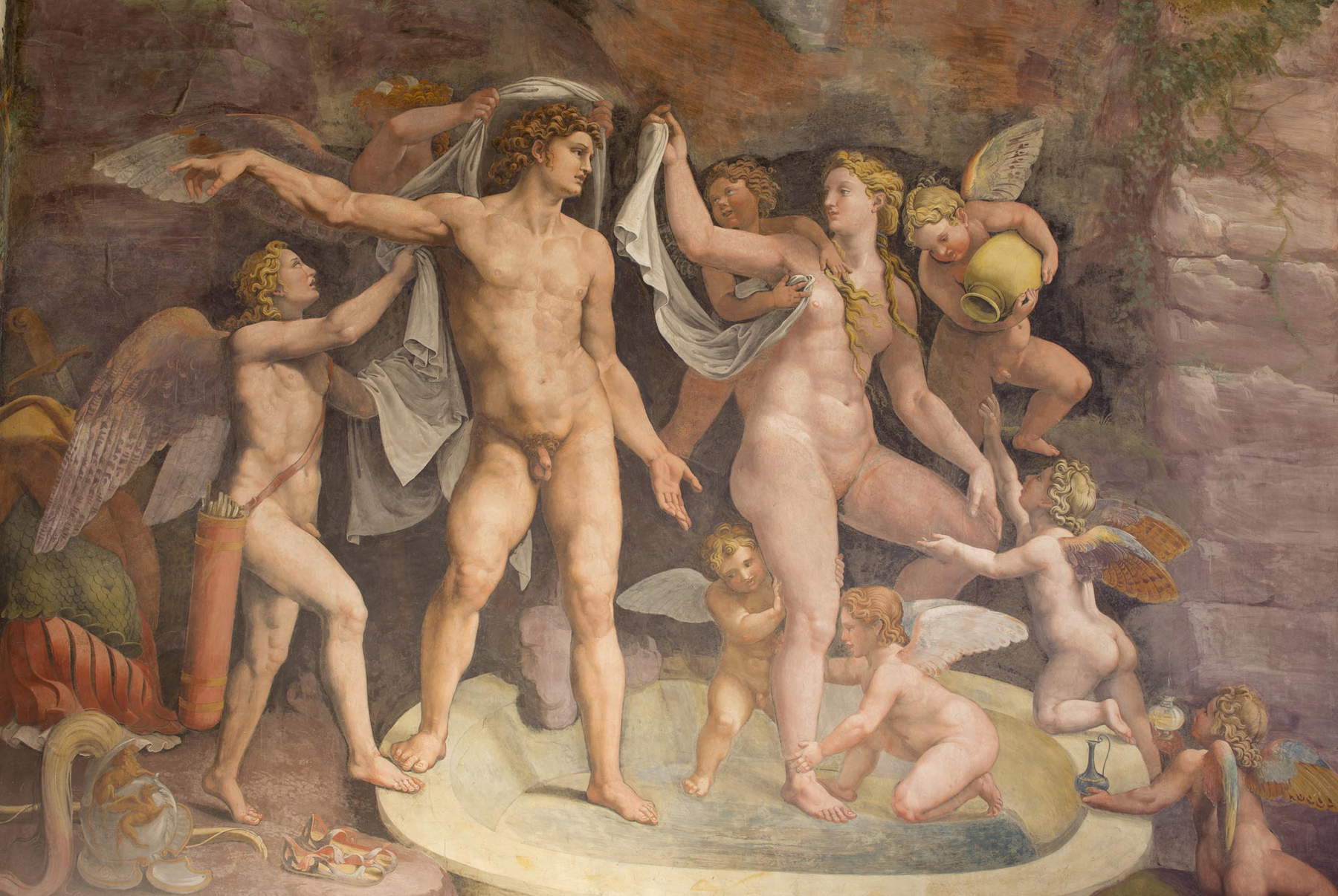 |
| Giulio Romano and pupils, The Bath of Mars and Venus (1527-1528; fresco; Mantua, Palazzo Te, Chamber of Cupid and Psyche). Photo: Gian Maria Pontiroli © Fondazione Palazzo Te |
 |
| Giulio Romano, Francesco Primaticcio and pupils, Venus disarms Cupid (16th century; fresco; Mantua, Palazzo Te, Vault and frieze of the Emperors’ Room). Photo: Gian Maria Pontiroli © Fondazione Palazzo Te |
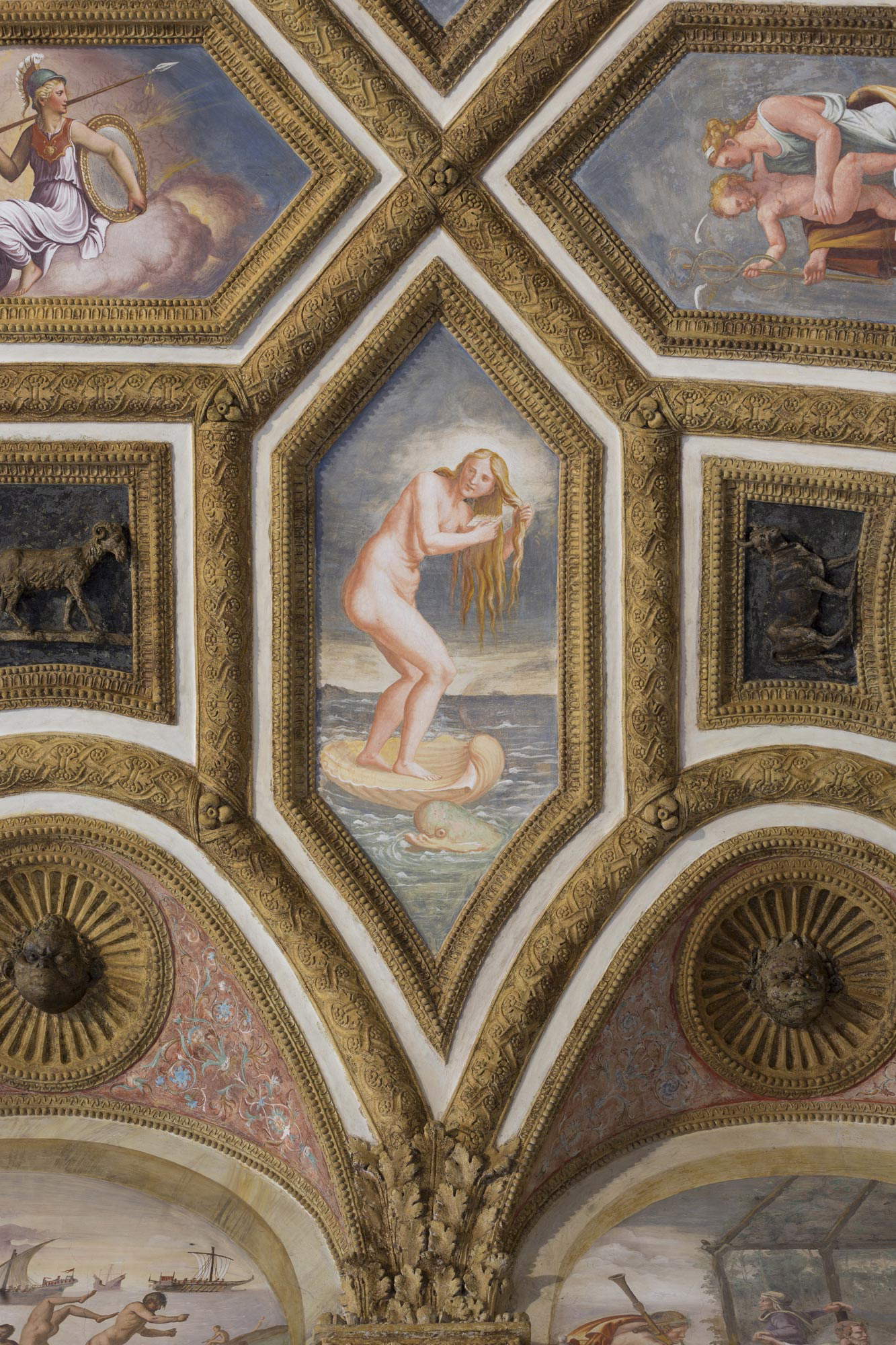 |
| Giulio Romano and pupils, Venus Anadiomene (1527-1528; fresco; Mantua, Palazzo Te, Vault of the Chamber of the Winds) Photo: Gian Maria Pontiroli © Fondazione Palazzo Te |
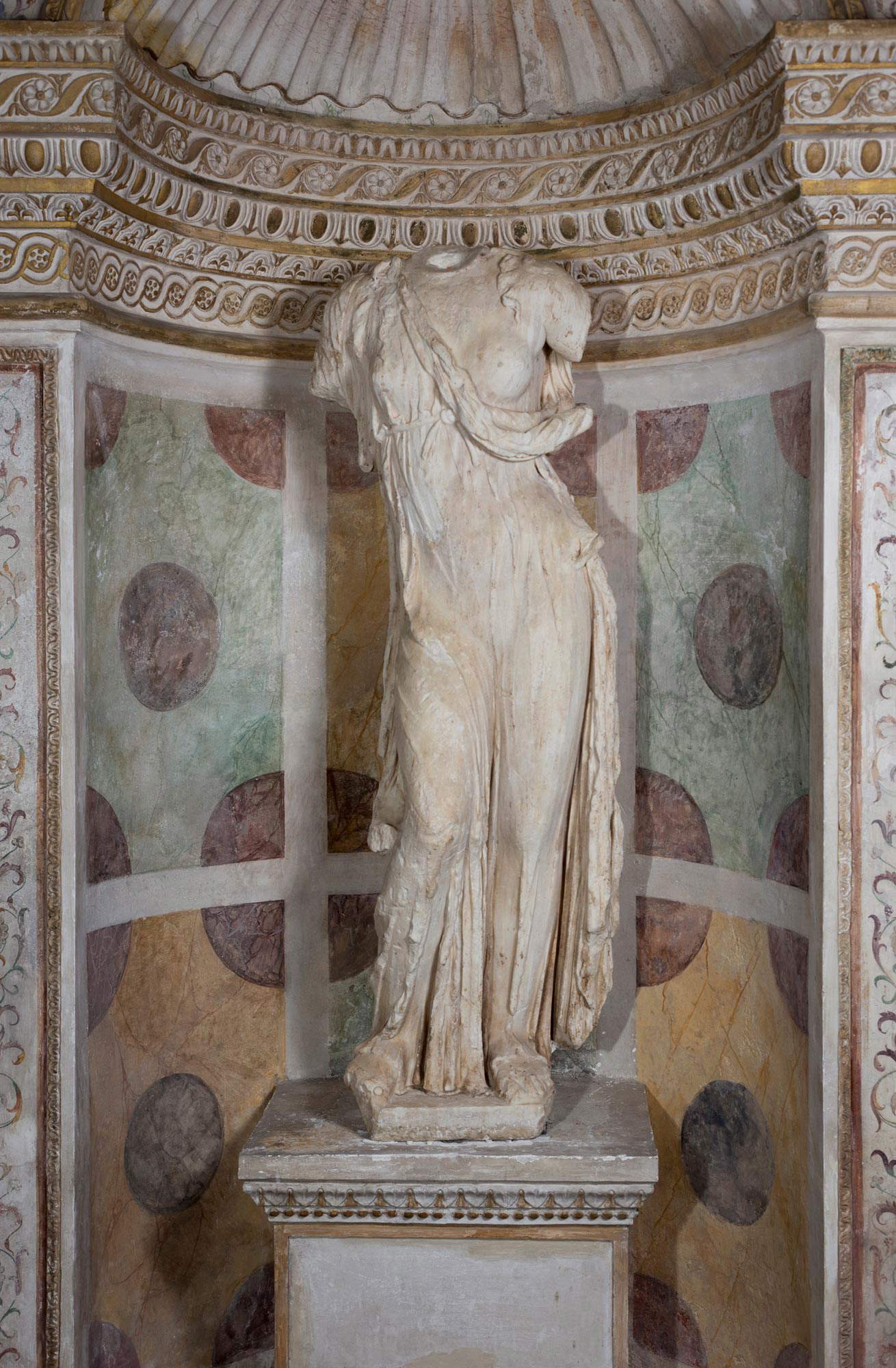 |
| Veiled Aphrodite (2nd century B.C.E.; Parian marble with yellowish patina, 133 x 50 x 45 cm; Mantua, Ducal Palace, Galleria dei Mesi, on deposit from Comune di Mantova) Photo: Gian Maria Pontiroli © Fondazione Palazzo Te On concession from MiBACT, Ducal Palace, Mantua |
 |
| Manufacture by Nicolas Karcher on cartoon by Giulio Romano, Venus spied by a satyr with cherubs (1539-1540; wool and silk tapestry; 410 × 450 cm) © Gian Maria Pontiroli for Fondazione Palazzo Te |
The second stop is scheduled for June 22 with the exhibition Titian. Venus Blindfolding Love, which until September 5, 2021 brings Venus Blindfolding Love, a masterpiece by Titian Vecellio conserved at the Galleria Borghese in Rome, to the halls of the Mantuan palace. The canvas by the Cadore master presents Venus in the act of blindfolding little Eros resting on her lap, while another putto, probably Anteros, observes the scene with an absorbed air. This work is part of the Venus divina project and constitutes one of the pinnacles of the representation of divinity in the 16th century. On the occasion of this exhibition, during the summer period, the exedra of Palazzo Te is rethought to host performance and artistic moments, part of the program dedicated to the theme of the Venus myth.
Titian’s painting is first mentioned in 1613, in the poem by Scipione Francucci, dedicated to the collection of Scipione Borghese, cardinal nephew for eight years, a collector who was, to say the least, passionate about ancient and modern painting and sculpture. Francucci describes the subject as Venus blindfolding Love while listing the comprimarios: another cupid and the two nymphs Dori and Armilla, one with arrows and the other with a bow. The scene has always been difficult to interpret, so much so that it acquired different titles in later inventories of the villa, where in the early 1620s Antoon van Dyck also saw it, as evidenced by a drawing in the Italian sketchbook, now in the British Museum. In the twentieth century more complex interpretations have been based on finding literary sources; Hans Tietze proposed Apuleius’s Metamorphoses, in which Venus punishes Cupid for falling in love with Psyche by commandeering his weapons. Erwin Panofsky formulated a neo-Platonic interpretation, identifying the two cupids as Eros and Anteros, that is, passionate love and divine love, which is not blind but able to contemplate true Love. Subsequent readings have partially undermined these interpretations, for by carefully observing the expressions of the characters, it actually appears that the two women are about to hand over their weapons to Cupid, rather than having taken them from him; the able-bodied Love, leaning on his mother’s shoulder, appears almost worried, rather than confident of his superiority to his blindfolded brother. Thus, it cannot be ruled out that the scene representsCupid’s Education: blind Love is about to perform his first exploits, striking mortals with his arrows and casually scattering falling in love and passion. The painting is dated between 1560 and 1565, in the artist’s extreme years. The image, crumbling and dreamy, is masterfully constructed: at the center of the painting is none of the protagonists of the scene, but an opening to a sunset landscape. In a sophisticated chromatic arrangement, pink and blue are found on the small wings of the blindfolded Cupid, and on one side in the blue of Venus’s drapery, opposed to the crimson red of the handmaiden with arrows. The whites of the robes and complexions are traversed by light, and delicate transitions to colored shadows help to blur the contours of the figures, left to the viewer’s eye and his or her ability to grasp them.
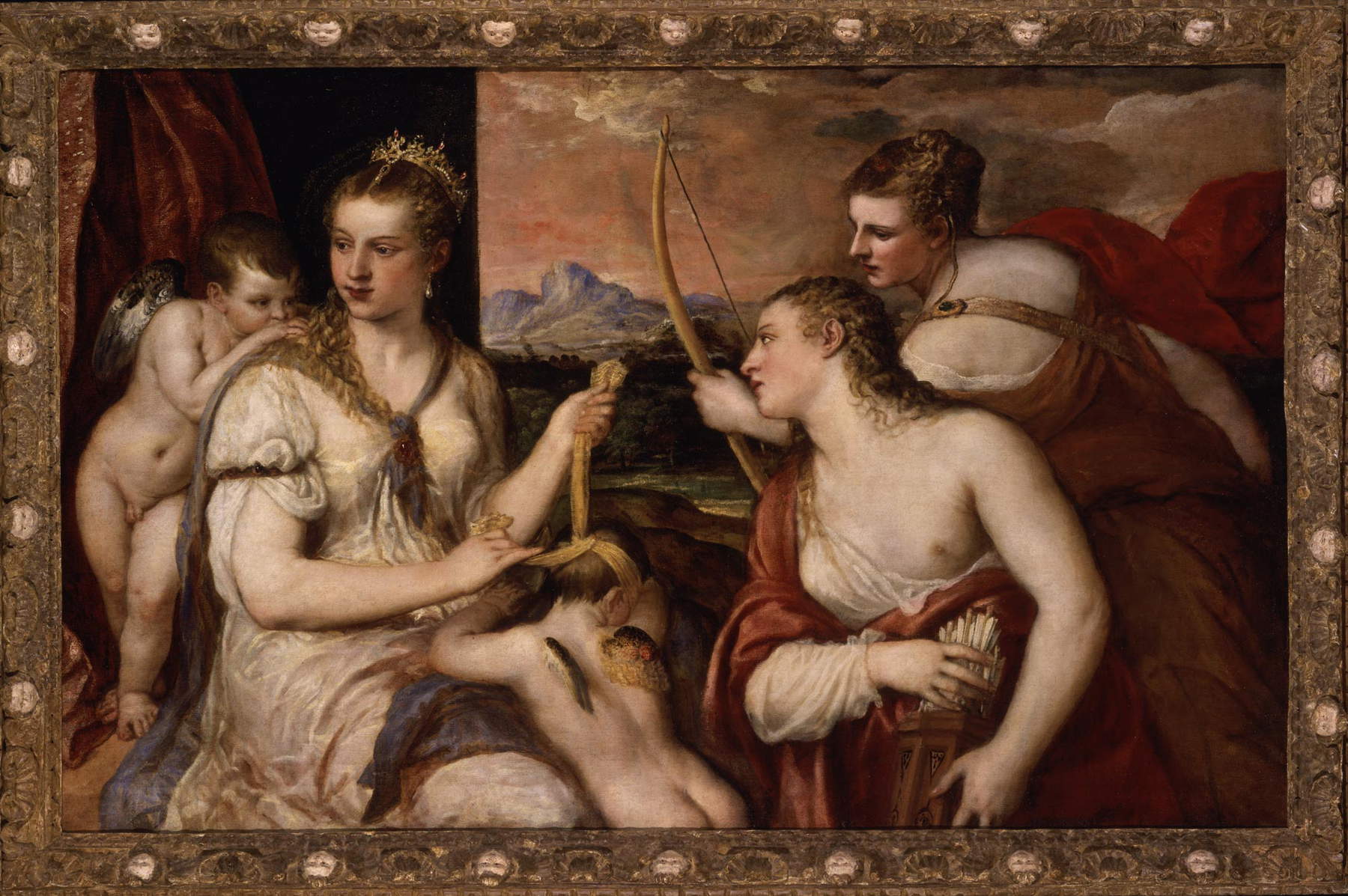 |
| Titian, Venus Bandaging Love (1560-1565?; oil on canvas, 118x185 cm; Rome, Galleria Borghese) © Galleria Borghese |
The last stage of the project is on September 12 with the exhibition Venus. Nature, Shadow and Beauty, curated by Claudia Cieri Via, which from March 21 until Dec. 12, 2021 investigates the origins of the myth and its creation, thanks to the sixteenth-century recovery of ancient legends and iconographies. The exhibition devotes part of the itinerary to the spread of myth in European courts, the deity’s connection with waters, gardens and parks, and with the beauty of the women of the time. A section is also devoted to the “dangers” of Venus and the connection of sorceresses and witches with the cult of the goddess. The exhibition project is curated by Lissoni Associati, and the graphic design is developed by Lissoni Graphx.
Through international loans and major works, the exhibition aims to explore the different faces of the goddess that populated European and Italian iconography in the 16th century, showing her lights and shadows, radiance and fury. The image of the goddess, which has spanned centuries while keeping her fame intact and her powers intuitive, from beauty to the ability to unleash and protect amorous passion, has had an enormous diffusion in figurative art, in the dual valence of a celestial Venus, naked and intangible, an astrological deity symbolizing perfect beauty and virtuous love, and an earthly Venus presiding over generation and amorous pleasures. The exhibition illustrates different aspects of the goddess, focusing on Venus genetrix and her harmony with the nature of gardens, a crucial aspect of Renaissance villa construction and decoration. The depiction of Venus, nude and perfect, raises the problem of the model, which for ancient sculptors had been, according to the testimony of the sources, a choice among living examples. The idea that a contemporary beauty could be modeled emerges in the early sixteenth century, when the existence of living Venuses, the inspiring muses of artists, is also theorized. One comes to think that a model could lend Venus not only her face but also her body. This is how the King of France, Francis I, receiving a Venus by Lorenzo Costa as a gift from the Marquis of Mantua, could ask if by chance a lady of the court had posed for the painting. If the exhibition initially declares the complex and elusive nature of the goddess and her depictions, it then wants to proceed to evoke her role within the decorative arrangements of the 16th and 17th centuries. Venus, beyond the simulacrum, is the protagonist of “fables,” legends and myths that have to do with nature, the place where her powers and events materialize. Mortals pay homage to Venus in lush gardens, and sometimes the goddess’s rest or bath is threatened by feral-looking beings, expressions of a primordial nature. Magical and irrational forces draw on humans when it comes to conquering a reluctant lover; potions and spells are tools of Venus, but of an inverted and dangerous Venus. The exhibition tour continues in aristocratic rooms, as in the courtesan’s dwelling, places where Venus is constantly depicted. Contemporary women are measured against her, whom the literary comparison pushes toward the mythological model: the sublime beauty of the goddess is the defining characteristic of women worthy of the portrait. Their images are soon grouped, like those of the goddess and ancient heroines, in thematic dressing rooms, like the rooms of the Belles.
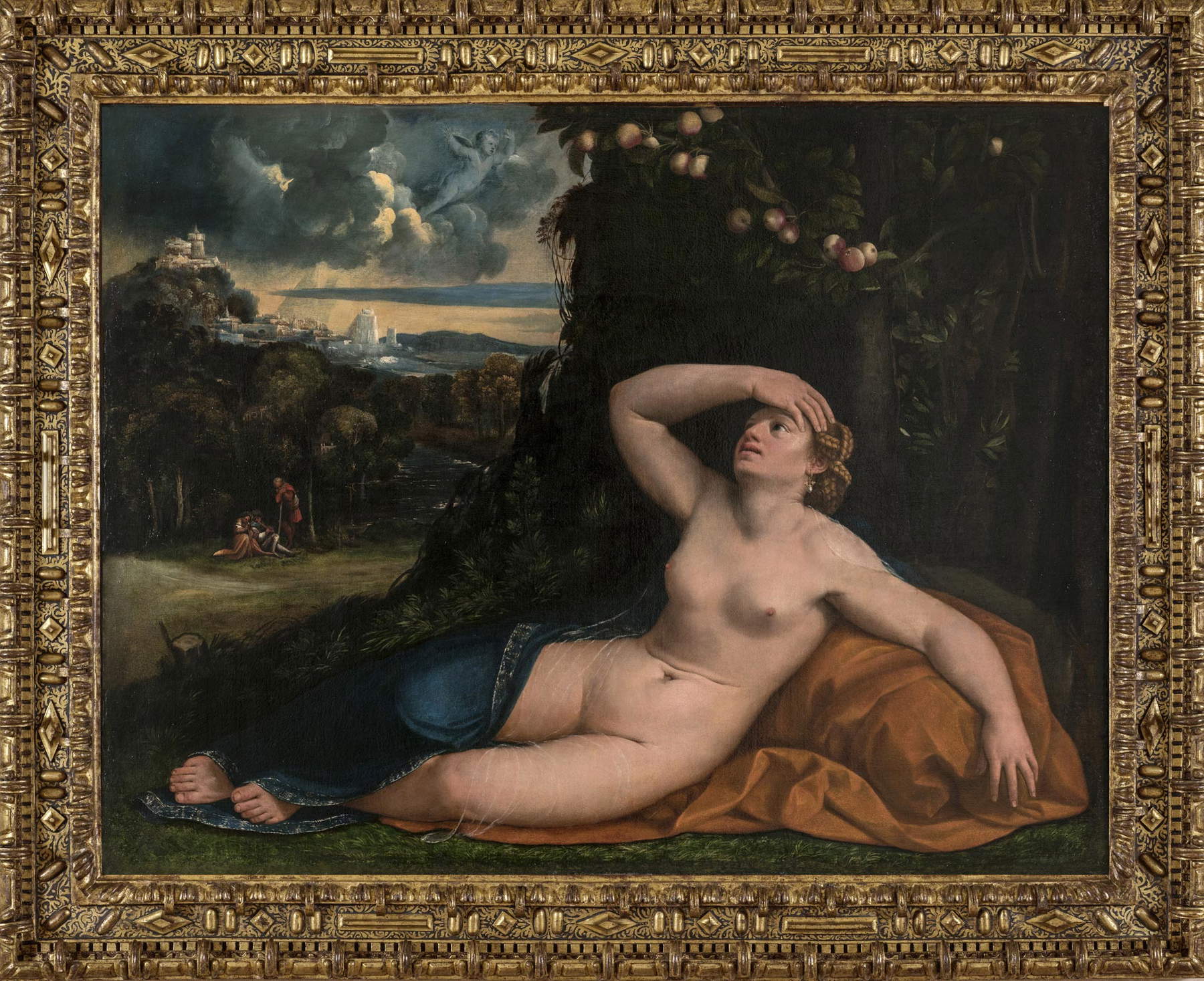 |
| Dosso Dossi, The Awakening of Venus (c. 1524-1525; oil on canvas, 120 x 157 cm; Bologna/Milan, Magnani Collection, pro-prietà Unicredit Milano) © UniCredit Milano Collection |
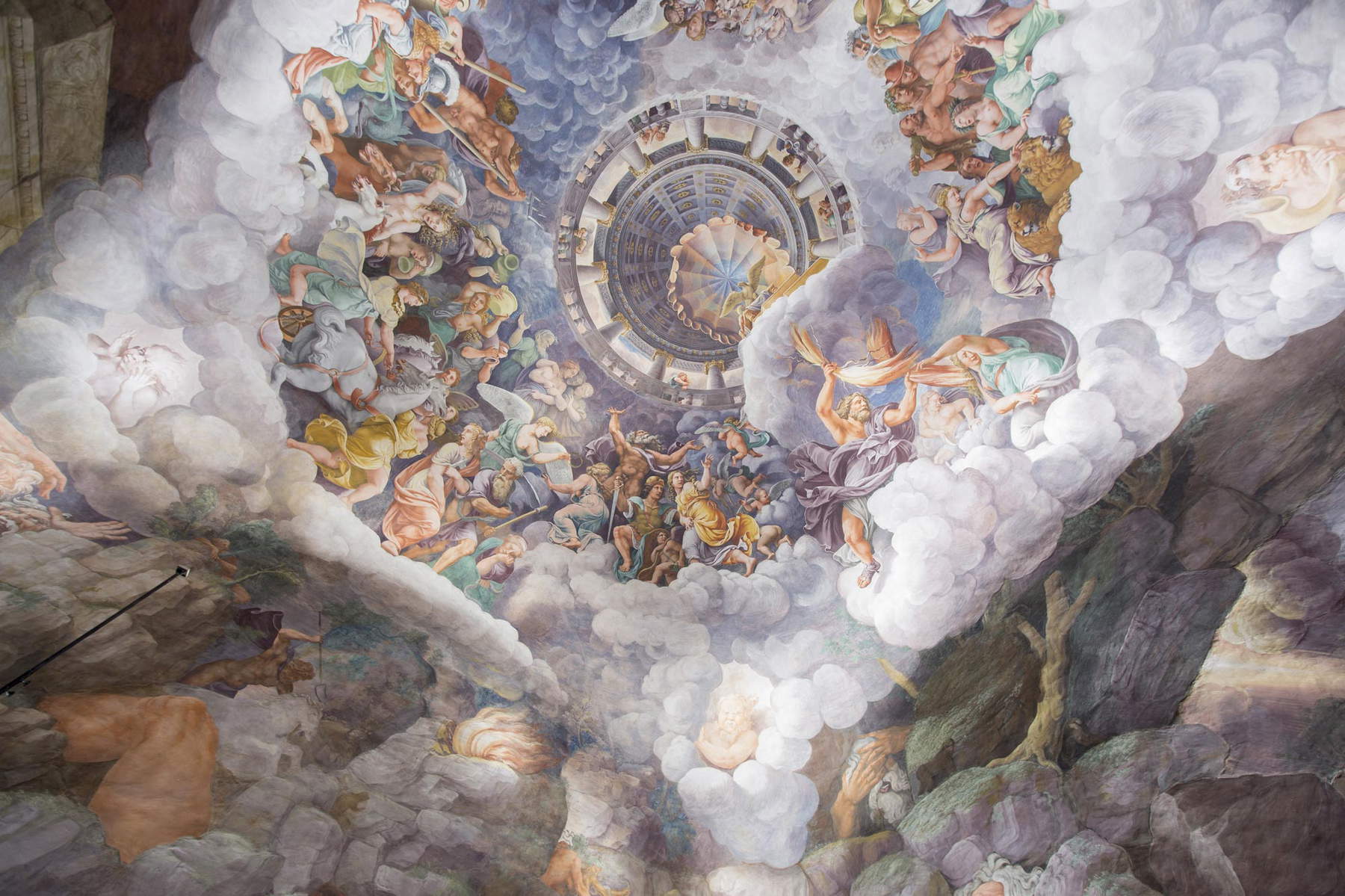 |
| Giulio Romano and pupils, Vault of the Chamber of the Giants (1530-1534; fresco; Mantua, Palazzo Te). Photo: Gian Maria Pontiroli © Fondazione Palazzo Te |
“Extraordinary times such as those we have experienced in these months,” says Stefano Baia Curioni, director of Palazzo Te, "demand from cultural institutions responses capable of restoring ways, times, places worthy of the human. No special effort is needed for this, perhaps only the strength to remember, to cherish simple evidences: to be well, we need to have our feet on the ground, our backs straight and our heads in the sky; we need the presence of others; we need to think that it will be possible to restore a harmony even outside our domestic walls. For all these reasons, while being aware of the risks that this choice may entail, we have decided to dedicate this year’s activities to the figure of Venus and her myths. An ancient figure well rooted in the Greek tradition, she has filtered into Roman and then Renaissance tradition, reverberating her canons and exceptions down to us. Aphrodite/Venus is a very special goddess, the daughter of a measureless love between Uranus and Gaea, she takes on the task of reknitting the broken threads, of reuniting heaven and earth. Her beauty is a shining consequence of harmony, of new peace, and so is the fertility, the capacity to generate that she continually renews. Palazzo Te is a mythical place in the sense that ancient myths live and relive in it, transfigured by the incipient modernity that urges but still does not find a face. And every time even today, in a surprising way, the narrative power of myth awakens before the eyes of those who wander through the halls, telling stories that allow us to trace ancient but foundational experiences of the human. This is why we have narrated the main myths told by the paintings of Palazzo Te on the Mnemosyne page of the Foundation’s website. This is why we now chose to talk about Venus: because it was important to continue the reflection on the feminine, which began in 2018 with the program on the Annunciation between Titian and Gerhard Richter and was then relaunched with Giulio Romano: art and desire in 2019, and above all we felt it was important to engage in a year-long wish for harmony. But the choice was certainly confirmed when we saw that more than twenty-five figures of Venus are represented at Palazzo Te, concentrated in the Sun and Moon room and in the room of Cupid and Psyche, but also present at other crucial points along the tour route. Why does Venus carry such weight in the iconology of a palace dedicated to metamorphosis, celebration, and politics? Certainly because such metamorphosis is oriented by the figure of Eros, son of Venus, not so different from his mother. Perhaps also because Venus guards and balances Eros, divine desire, and brings him back to a kind of place of origin, those instants of harmony in which the stigmata of beauty are irresistibly inscribed."
“Palazzo Te,” says Mattia Palazzi, mayor of Mantua, “is a heritage of humanity. Well known to scholars all over the world, a living symbol of culture and art. Today, rightly, it stands at the forefront of those illustrious places that intend to reopen their doors, inaugurating a new path of research, exhibitions and comparison. But Palazzo Te is also a beloved home for all citizens of Mantua, who periodically explore these halls, admiring the beauty brought together by Giulio. The master of invention succeeded here in inaugurating and consolidating an aesthetic revolution that changed the course of architecture and painting itself, becoming the supreme point of synthesis between the ideals of classical Greece, ancient Rome and Raphael’s new Rome. The Juliesque revolution, precisely, still speaks to us today. It does so in the sign of splendor and wonder, accompanying with a poetic sigh the divinities that run through the walls, the dressing rooms, the halls, the loggias, the subject in our years of a careful intervention and a new valorization. The Fondazione Palazzo Te has therefore wisely decided, in agreement with the city administration, to imagine an entire year dedicated to the figure of Venus, which summarizes the strong sensual component of sixteenth-century paintings, the fickle interweaving of modernity and classical art, and is finally a sublime example of the continuous variation of modes and styles that takes place here. Thus Venus, beginning in the famous room of Cupid and Psyche, is the goddess who seems to oversee the entire development of the narrative that unfolds among these frescoes and stuccoes. She, the mother of Aeneas, is already from Virgil’s time the exemplification of desire itself, of creative yearning, of the survival of a dynasty. Thanks to the invaluable collaboration with the Ducal Palace, the Foundation has therefore proposed a three-stage journey, revealing the multiple Venuses present before our gaze. Opening doors, approaching visitors, stimulating scholars to new investigations and interpretations is the starting moment for the cultural renaissance of our city and, we would like to say without modesty, also of all of Italy. Following the appropriate precautions, but directed toward an even wider opening, and comforted by the excellent outcome of the previous exhibition on Giulio Romano, we hope that this will be one of the many steps taken by our cultural community as it continues the excellent planning carried out by the Foundation, its President and Director, following in time the stimuli that our time proposes, linking, as has always happened here, the art of the past to the most lively and current proposals.”
 |
| Mantua, it's the year of Venus: big exhibition at Palazzo Te on the myth of the goddess of love |
Warning: the translation into English of the original Italian article was created using automatic tools. We undertake to review all articles, but we do not guarantee the total absence of inaccuracies in the translation due to the program. You can find the original by clicking on the ITA button. If you find any mistake,please contact us.